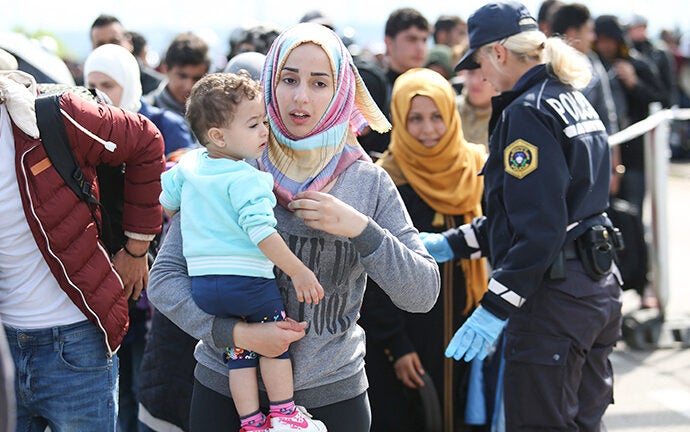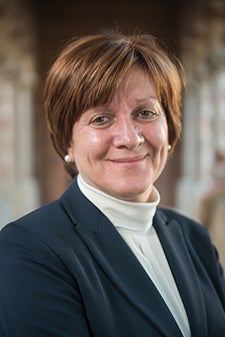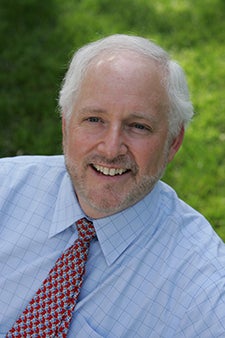
USC Dornsife experts analyze Europe’s refugee crisis: Part 1
A five-minute taxi ride from the center of Calais, past the neat, white houses and manicured gardens of this northern French port city, lies a sprawling, makeshift refugee camp that media and politicians have dubbed the “New Jungle.” Here some 6,000 desperate people, mostly from Syria, Sudan, Iraq and Afghanistan, hope to reach the United Kingdom. In the meantime, they live in inhumane conditions in what human rights groups have called “the largest slum in Europe.”
As children play in the mud and elderly people huddle together for warmth, winter is fast approaching. With it will come rain, freezing temperatures and the increased risk of pneumonia and other life-threatening diseases for these exhausted people who fled their war-torn homelands in the hope of creating a better, safer future for their families.
More than 4 million Syrians have left their country since unrest erupted in 2011 followed by civil war a year later. In the largest flow of refugees since World War II, more than 750,000 refugees and migrants have arrived in Europe this year alone, of whom 38 percent are from Syria. With little sign of the crisis abating, Europe is struggling to cope.
Willing to risk their lives for a better future
“One thing we know about migrants who make these difficult journeys is that in many cases they simply reach the point where they feel it’s no worse to die than to remain where they were living,” said Laurie Brand, Robert Grandford Wright Professor and professor of international relations and Middle East studies, and director of the Middle East Studies Program at USC Dornsife.
It’s also known that many refugees and migrants do not survive their attempt to reach safety in Europe. Altogether, more than 3,400 people have died in the Mediterranean Sea since the beginning of the year.

Laurie Brand, Robert Grandford Wright Professor and professor of international relations and Middle East studies, and director of the Middle East Studies Program. Photo by Peter Zhaoyu Zhou.
“The number of young people and children that we have seen drowning and washing up on European shores over the last year speaks to the real desperation, not just of breadwinners, but of entire families,” Brand said.
As more people flood into Europe each day, the images now being shown in the media of the continent’s woefully inadequate refugee camps are in brutal contrast with the heartwarming footage from early September that showed cheering Germans gathered at railway stations to welcome weary and grateful refugees.
Some European countries have offered to take only limited numbers, while others have balked at taking any. In a move condemned by other European Union members, Hungary erected barbed wire fences along its borders with Croatia and Serbia to keep migrants out.
Germany took 218,000 refugees in October, but on Nov. 11, alarmed by the continued flow of migrants across its borders, the country made a U-turn. German interior minister Thomas de Maizière ordered that asylum seekers should be deported back to the EU state they first entered.
Educated and skilled
Many of the Syrian refugees who have recently arrived in Europe are educated, urban, middle-class and skilled. As Brand pointed out, many speak English or French well. They are engineers, teachers, nurses and architects.
“Ironically, the economies of France, Italy and Germany have long depended on immigrant labor, and their birthrates are so low that their economies will actually shrink and become poorer unless they welcome immigrants,” said Robert English, associate professor of international relations, Slavic languages and literatures, and environmental studies, and interim director of the School of International Relations.
“However, when refugees arrive in this fashion — in one sudden surge and especially from an Islamic country — the political pushback becomes intense.”
This need for millions of skilled workers to replace its dwindling population was one of the reasons Germany was initially keen to accept the refugees.

Steven Lamy, professor of international relations and vice dean for academic programs.
“Part of Germany’s willingness to take refugees also has a lot to do with the country trying to find its place in the world,” said Steven Lamy, professor of international relations and vice dean for academic programs. “Part of that is colored by their history and part by the fact they are emerging as the European superpower.”
However, Germany’s efforts to lead its EU partners in sharing in the resettlement of refugees have largely failed.
“Germany is disappointed that the other EU members have not stepped forward to share the burden as it had hoped,” Lamy said.
France, which already struggles with its own large North African population, has offered to take just 24,000 refugees. As a smaller country, the U.K. has less capacity and is already dealing with large numbers of immigrants from Eastern Europe and the Commonwealth. British Prime Minister David Cameron has offered to take only 20,000 people by 2020.
In smaller countries with a history of instability, like Slovenia for example, the population and its leaders are keen to maintain the newfound stability they have gained through EU membership and are therefore unwilling to take in refugees, Lamy said.
Will the rise of the far right kill European multiculturalism?
A more sinister and worrying reason for Europe’s failure to follow Germany’s lead is the rise of far right, anti-immigrant parties that are proliferating throughout the continent.
“We’re seeing rising intolerance in even the most historically tolerant societies — those of the Nordic countries — Norway, Sweden, Denmark, Finland — and even in the Netherlands, where there is an increase in anti-immigrant rhetoric and the rise of nationalistic right wing parties,” said Lamy. “Indeed, European multiculturalism, as espoused for many years by the Netherlands, seems to be coming to an end. If the Dutch give up on multiculturalism, then that’s a very bad sign.”
If Western European countries have long been accustomed to multiculturalism, Eastern European countries like Hungary, Croatia, Romania and Bulgaria were closed under communism for so long that much of the population is still adjusting to this brave new world of movement of people of different races, languages and ethnicities, English pointed out.

Robert English, associate professor of international relations, Slavic languages and literatures, and environmental studies, and interim director of the School of International Relations. Photo by Peter Zhaoyu Zhou.
“They’re much more conservative, they hew to traditional values and they’re simply baffled and frightened,” he said.
Hungarian leaders were already pushing back against Western European multiculturalism and tolerance even before refugees from Syria and the Middle East started arriving at Hungary’s borders, English added.
“Now this surge of what they see as ‘alien people’ is a gift to the far right, and the backlash is enormous,” he said. “There is this perception that the refugees will take money and public resources that should be spent on ‘us,’ the ‘real’ Hungarians.”
These feelings are exacerbated by economic inequality, with citizens of Hungary and Croatia earning well below a third of the average income of their German EU partners. Countries like Serbia and Bosnia are even poorer.
“These countries are poverty stricken, so their resources to support and feed people or to roll out fences and police — whatever is needed to manage a large flow of refugees — have been stretched incredibly thin,” English said. “Understandably, leaders don’t want to welcome any new burden. And the refugees, even if they are moving through, are a burden, straining these country’s resources to breaking point.”
The root cause: concern over resources
Right wing commentators have laid the blame for unwillingness to take in refugees on a fear of terrorist infiltration. Lamy noted while this is a legitimate concern, as evidenced by the recent attacks in Paris, it isn’t the main cause of European reluctance to take in refugees. That lies in competition for scarce — or what are perceived to be scarce — economic resources. That is traditionally the root cause of most ethnic conflict.
“This is the critical issue,” Lamy said “There are elements of anti-Islam and the notion of ‘The Other,’ but I think that is minor compared to the real concern over the distribution of resources within these countries.
“There is a real uncertainty and concern for the well-being of their own citizens. They’re saying, ‘Look, we’re not sure there is enough money for us, so we’re not willing to share it with others, especially outsiders.’ And now even Germany — one of the most stable economies in the region — is asking, ‘Is there enough for us?’”
In Part 2 of this three-part series, USC Dornsife experts explore who is responsible for this unprecedented flow of refugees. In Part 3 our scholars speculate on the long-term implications of the Syrian migration and suggest a possible silver lining to the current crisis.